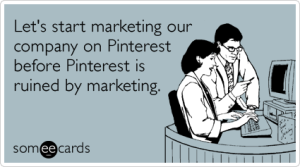 If there’s one thing you take away from today’s post on content marketing, please let it be this: just because you build it, doesn’t mean they’ll come.
If there’s one thing you take away from today’s post on content marketing, please let it be this: just because you build it, doesn’t mean they’ll come.
Content Marketing: a scenario
Scene: your client is super-excited about its new content marketing program (that you’ve been hired to design, and implement). You’re super-excited too – content, new client, money… what’s not to love?
So you put it together. You spent the first few months creating great blog content (in your opinion, and let’s assume, for the sake of argument, your opinion is spot on). Then you started distributing said content through Facebook, Twitter, Pinterest… maybe other platforms as well. But three or four months down the road, your client is unhappy with the lack of shares and “engagement.”
Aaaahhh!!! What gives? Are they crazy and overly-demanding? Or is there something you’re not doing… or, worse yet, does your plan suck?
My guess is: a bit of both, without the extremes. Your client probably isn’t crazy, but perhaps a little under-educated on how all this works (which is why they hired you, you’re the expert). And your plan probably doesn’t suck, because you are smart. But you’re probably not approaching content marketing the social PR way.
And that, my friends, is the difference. You may have created great content, and you may have a good distribution plan, but shares and engagement are unlikely to come unless you have also focused on community building.
Any content marketing plan is incomplete if it doesn’t account for mechanisms to draw people in, as opposed to simply pushing the content out.
Here are four ways to do this, and we’ll start with the easiest first.
1. Play the “help me please” card, with your personal network.
Word to the wise: do this sparingly. It didn’t seem to matter as much a few years ago, and I don’t think people have become inherently unhelpful since social took off. But now, the sheer volume of content out there, not to mention individuals becoming well aware of their personal influence, means that every such request runs the risk of being pesky at best, and rude at worst.
If you have good relationships with folks who don’t mind helping with shares, by all means, reach to them. Just remember to say “thank you” and reciprocate when asked (h/t Betsy Decillis).
2. Automation and tools.
Mechanisms like Triberr (which I’ve written about before, and which I still use… sparingly) often work from the reach point of view, but usually not much else. But if you’re looking for sheer reach and shares, definitely check them out.
In addition, dynamic comment systems like Livefyre (which is what we have here on WUL) can integrate shares/comments from Twitter & Facebook. Every time you reply to a tweet sharing a blog post link, for example, Livefyre counts it as a comment.
You can also set up recipes in IFTTT to reply to tweets, and so on. But I will tell you – as I always do – please be smart about how you use tools, because they can really backfire.
For example, you know how, a while back, I used to say “good morning” on Twitter every day? Well, I’ve noticed some people automating similar greetings through IFTTT. I’d even toyed with the idea of doing it myself, but my visceral reaction to these folks was, “What? You can’t even say ‘good morning’ in person?” So I didn’t. And everyone who’s doing it: Please. Stop. It.
Translate this to the corporate plane, and the visceral reaction will still occur. If people start to think everything about your client is automated, they probably won’t like it.
3. Smart, active engagement.
This (and #4) is where I’d put my money first, if I were you, and only then go to #2, and then #1.
This means looking for the right places and conversations in which to participate (e.g. Twitter chats). Engaging with others without looking for something right off the bat. Commenting on blogs published by the kinds of people you hope will come over and comment on your blog. Looking for guest post opportunities. Etc. etc. etc.
4. S.E.O.
All your content isn’t worth a dime if it’s not also optimized – in as human a way as possible – for search engines. Here’s a post Sean McGinnis wrote a while back on using keywords to do this. Also this from Shelly Kramer on how to write blog headlines people will actually click on (and who reminded me that SEO’s really important as well, when it comes to content marketing).
Now, all these elements have to play together nicely, for your program to work well. Remember that Google’s bringing tweets back into search results, and on Tuesday, its new mobile-friendly approach goes into effect.
This means that if, as you’re working on your content marketing plan, you’re not also thinking of mechanisms to get people to engage with that content, and make it accessible and “engageable” (if that wasn’t already a word, it just became one) from mobile devices, you’re toast. Or soon will be, as far as The Goog is concerned.
In a nutshell
Pushing out content is all very well, but unless you build a community, there will be limited-to-no engagement with your content. And unless people are engaging with said content, it’s not going any higher in SERPs. And if it doesn’t go higher in SERPs, it’s not going to get shared, or further engagement.
Yup. It’s a loop guaranteed to drive you crazy… until you start putting all these elements into play.
So. You built it.
And while they won’t come just because you did, one thing I promise you: if you reach out, they will come. They may amble, rather than race, but they will come.
Thanks to everyone in the #soloPR community, which is where this question originated, where I first answered it, and without which this definitely wouldn’t have been today’s blog post!
![[EVENT]: PR Hacks for Small Biz (online)](https://shonaliburke.com/wp-content/uploads/2021/06/FB-Ad-1200x800-01-01-01-Copy-500x383.jpeg)








[…] 5. Content Marketing: Without Community, It’s Only Half the Equation […]
Narciso17 Narciso of The Caps is Back!!!!
rosemaryoneill AAAAHHHH! I did! And they are! Nice.
My name is Baumgardt, and I base in CALIFORNIA, USA…My life is back!!! After 5 months of Broken marriage, my husband left me with two kids . I felt like my life was about to end i almost committed suicide, i was emotionally down for a very long time. Thanks to a spell caster called DR. PayBack which i met online. On one faithful day, as I was browsing through the internet,Some people testified that he brought their Ex lover back, some testified that he restores womb,cure cancer,and other sickness, some testified that he can cast a spell to stop divorce and so on. i also come across one particular testimony,it was about a woman called Marie ,she testified about how he brought back her Ex lover in less than 2 days,he is the answer to your problem. here’s his contact:Email on nyamedeathspells@gmail.com, http://www.quickrevengespells.com
I want to testify of this great death spell caster. This great man helped me cast a death spell on my wicked step father and just within 48hours the wicked man had a motor crash and died. All thanks to this great death spell caster called instant death spell. You too can contact him now for an urgent death spell cast on anyone, quickrevengespell@yahoo.com,
“With your revenge spell, my foreman was fired the next day! This is the same #%$!@ that canned me. Serves him right. Ricco, (my foreman) was practically in tears when he left the bosses office. The only thing I regret is not having my camera. I want to order a custom spell now!” quickrevengespell@yahoo.com, Anthony Y, Florida
I was looking for powerful magic spells for love. I was upset and depressed. Dr PayBack helped me finding my true love. I will never go to any other spell caster except Dr PayBack. quickrevengespell@yahoo.com, John (San Antonio TX)
“Like anybody would be, I was very skeptical about using a love spell or any spell for that matter but I was absolutely shocked when Tim called me after I had you guys cast my “Return My Lover” spell for me. It wasn’t 24 hours that I had my spell cast that he came back to me (practically on his knees). He broke up with me over a month ago and now we are happier than ever. Thank you all!” quickrevengespell@yahoo.com, Dorothy Rodriquez, New York
“I missed my ex bad. My family and friends were tired of me being so upset one of them actually ordered a Love Spell for me From Extreme Spells I had no idea what they had done. They ordered the GLOBAL LOVE SPELL as it your best and most powerful and effective Love Spell. Needless to say, I was shocked to see my wife at the door a week later with her eyes full of tears, .I cannot believe how well my spell worked. I recently ordered a Money Spell because who doesn’t need extra money?” quickrevengespell@yahoo.com — William, Nashville
SAVE YOUR MARRIAGE; http://quickrevengespells.com
Join the thousands who have used our services to get REVENGE!
Revenge on ex-lovers; http://quickrevengespells.com
Revenge on ex-spouses; http://quickrevengespells.com
Revenge on backstabbing friends; http://quickrevengespells.com
Revenge on pranksters; http://quickrevengespells.com
Revenge on co-workers; http://quickrevengespells.com
Revenge on bosses; http://quickrevengespells.com
Husband and WIFE PROBlem solution +2347030759636
LoVe mArrIaGe PrObLeM sOluTiOn Uk,UsA +2347030759636
End Your Divorce: To Stop a Divorce in Uk,UsA +2347030759636
B0Y/GIRL problems Solutions; +2347030759636
FERTILITY Problems; quickrevengespell@yahoo.com
GET eX Lover Back in 48hrs; http://quickrevengespells.com
Personal Misery Disguised as a relationship Problem http://quickrevengespells.com
My Husband Abuses Me and Now Wants Me to Leave: http://quickrevengespells.com
Couples FIGHTS : http://quickrevengespells.com
saveYOUR MARRIAGE; http://quickrevengespells.com
I wanted him back so much the feeling was almost suicidal(love is a bitch) http://quickrevengespells.com
I want to testify of this great death spell caster. This great man helped me cast a death spell on my wicked step father and just within 48hours the wicked man had a motor crash and died. All thanks to this great death spell caster called instant death spell. You too can contact him now for an urgent death spell cast on anyone, quickrevengespell@yahoo.com,
Shonali rosemaryoneill I personally love what Kids with Food Allergies has done. They are providing a valuable set of resources for a defined niche, and using their community as the center of gravity. If you Google anything related to kids and allergies, they are on page 1.
As Noted on Twitter, Since You’re Looking at This From a
Practitioner-Client Standpoint, I Would Add In a Few More Tips:
+ I Would ‘Frontload’ The Idea w/Your Client That This Will
Take Time. Like Rome, This Empire Will Not Be
Established in 3-6 Months.
– It Is
Essential That You Manage Their Expectations and Let Them Know That They May Get
Some
Results, But Unless You *Buy* Results (Eww), The Numbers They May Have In
Mind Will Just Not Be
There.
+ Secondly, The Idea of Developing an ‘Uncomfortable’ Place
for The Client May Do Them Some Good. By
‘Uncomfortable’ Place, I Mean That You
Should Develop Ideas That Push Their Cultural (Biz-Wise)
Boundaries.
– If They
Really Wish To Nab Some Meaningful Results (Not Just Numbers-Wise), They Need
to Re-Think
What They Are Actually Saying To Their Audience and How. Make Them
Uncomfortable, Challenge
Them and Make Them Dig Down Even Deeper Into What
*Drives* Them. Get Personal.
– This Exercise Will Probably Uncover More Of Their
Personality Than They Are Currently ‘Revelaing’ In
Their Marketing.
– When You Do
This, You Have Given Them Permission to Being Real. I Mean Really …’Real’ https://twitter.com/hashtag/FoReals?src=hash
Moreover, Getting ‘More Real’ Will
Most Likely Help Shape a ‘Next Chapter’ In Your Content Marketing Efforts, Give
You More Room/Time to Grow. PLUS, This Will, More Than Likely, Help You
Discover New (and Relevant) Communities, Which Then Opens Up New Opportunities
for Sales.
@Libby It is SO hard. Because it takes time and energy; it’s literally like being a cheerleader for the cause/community. I remember kanter talking about this shortly after we wrapped the #bluekey campaign. I think one of the hardest elements is that clients/organizations want to see the results really quickly, but you just can’t ask people to go out and do something for you before they feel comfortable… and that takes time!
Thanks much for stopping by – I appreciate it!
rosemaryoneill That’s so true, Rosemary. This reminds me of the case study I often share, about Oracle’s Topliners community – that’s exactly what they did, and the SEO and PR benefits were absolutely remarkable. Who else, in your opinion, is doing this well?
Great points here Shonali! And I’d add that building an owned community (on your website) can be excellent content marketing as well, since you are building a lasting, dynamic resource that can really help your SEO!
It’s true that community building really is important, but it’s also the hardest part of content marketing. That’s why I feel so many downplay its role. Thanks for the fresh perspective.